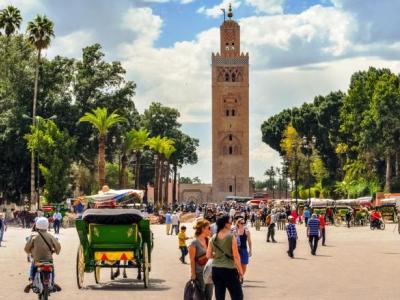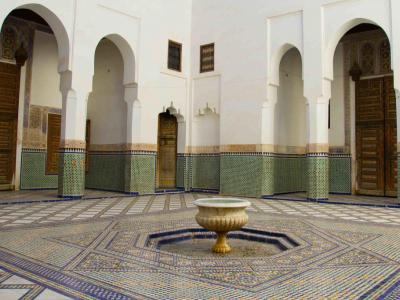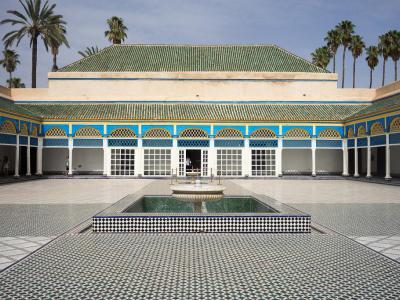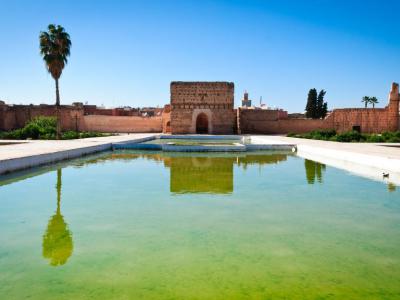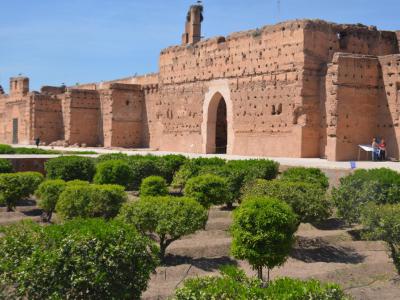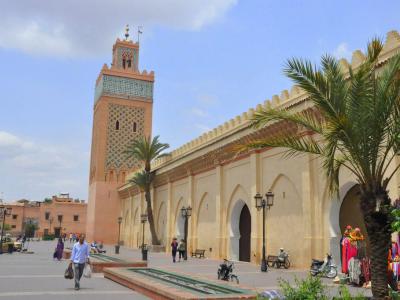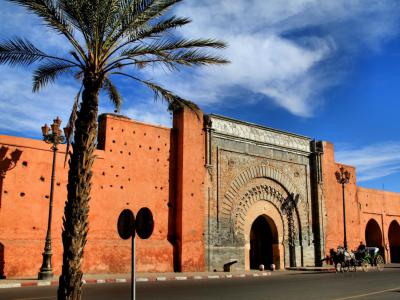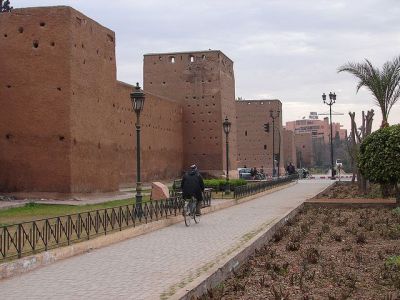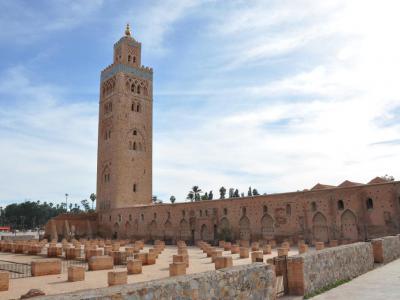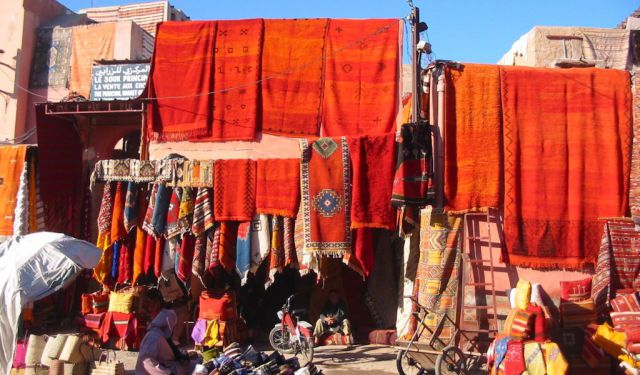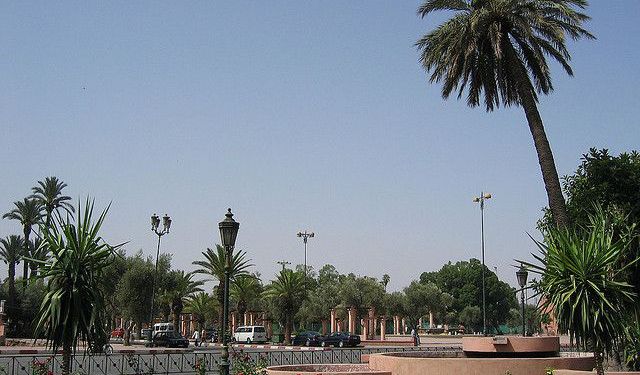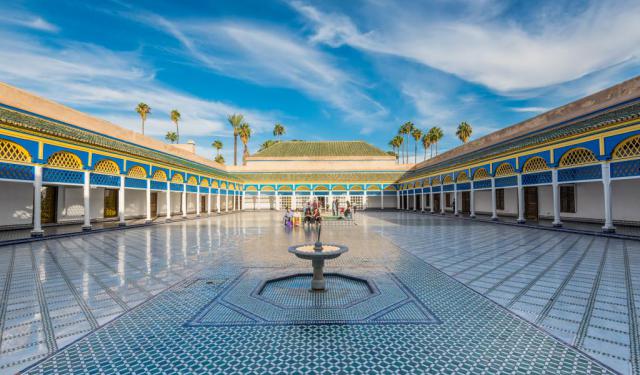Marrakech Introduction Walking Tour (Self Guided), Marrakech
“The sunset over Marrakech is like nothing else in the world.” Winston Churchill clearly could not hide his admiration for the city. The proof lies in the more than fifty trips he made throughout his life, many of them marked by his paintings of Marrakech—especially of that glowing, unforgettable sunset.
Marrakech was founded in 1070 by the Almoravids, a Berber dynasty that transformed a barren plain at the foot of the High Atlas Mountains into a major political, spiritual, and commercial centre. Its name is widely believed to derive from the Berber phrase amur akush, meaning “Land of God.” European travellers later adopted “Marrakech” as a label for the wider region, an echo preserved in the modern country name “Morocco.”
Although Berber communities lived in the surrounding region since prehistoric times, the city itself began with Almoravid expansion. Early rulers fortified their new capital with strong walls, founded schools and religious institutions, and encouraged trade routes linking North Africa, the Sahara, and Andalusia. The red sandstone ramparts built in the early 12th century earned Marrakech its lasting nickname, the “Red City.”
In the 12th century, the Almohads seized control and reimagined Marrakech as the capital of an empire stretching across northwest Africa and into Spain. Their rule brought administrative reforms, large-scale city planning, and monumental building projects.
Another flourishing era came under the Saadians in the 16th century. Fueled by wealth from trans-Saharan trade and influential diplomatic ties, they cultivated a sophisticated court culture, investing heavily in architecture, craftsmanship, and the decorative arts.
French rule beginning in 1912 introduced a new administrative layer. Colonial planners developed modern infrastructure and built a European-style district while preserving the old district. This approach created the distinctive contrast between historic and contemporary Marrakech, even after Morocco's 1956 independence.
A walk through Marrakech’s medina leads you through narrow alleys filled with spice stalls, carpet shops, and brass workshops. You’ll pass the minaret of the Koutoubia Mosque, the bustling spectacle of Jemaa el-Fnaa square, and the shaded courtyards of markets. Hidden gardens, ornate riads, and mosaic-lined doorways appear between stretches of red-ochre walls. Street vendors, storytellers, and fresh coffee create a lively atmosphere where centuries of history and daily life meet at every corner.
Marrakech was founded in 1070 by the Almoravids, a Berber dynasty that transformed a barren plain at the foot of the High Atlas Mountains into a major political, spiritual, and commercial centre. Its name is widely believed to derive from the Berber phrase amur akush, meaning “Land of God.” European travellers later adopted “Marrakech” as a label for the wider region, an echo preserved in the modern country name “Morocco.”
Although Berber communities lived in the surrounding region since prehistoric times, the city itself began with Almoravid expansion. Early rulers fortified their new capital with strong walls, founded schools and religious institutions, and encouraged trade routes linking North Africa, the Sahara, and Andalusia. The red sandstone ramparts built in the early 12th century earned Marrakech its lasting nickname, the “Red City.”
In the 12th century, the Almohads seized control and reimagined Marrakech as the capital of an empire stretching across northwest Africa and into Spain. Their rule brought administrative reforms, large-scale city planning, and monumental building projects.
Another flourishing era came under the Saadians in the 16th century. Fueled by wealth from trans-Saharan trade and influential diplomatic ties, they cultivated a sophisticated court culture, investing heavily in architecture, craftsmanship, and the decorative arts.
French rule beginning in 1912 introduced a new administrative layer. Colonial planners developed modern infrastructure and built a European-style district while preserving the old district. This approach created the distinctive contrast between historic and contemporary Marrakech, even after Morocco's 1956 independence.
A walk through Marrakech’s medina leads you through narrow alleys filled with spice stalls, carpet shops, and brass workshops. You’ll pass the minaret of the Koutoubia Mosque, the bustling spectacle of Jemaa el-Fnaa square, and the shaded courtyards of markets. Hidden gardens, ornate riads, and mosaic-lined doorways appear between stretches of red-ochre walls. Street vendors, storytellers, and fresh coffee create a lively atmosphere where centuries of history and daily life meet at every corner.
How it works: Download the app "GPSmyCity: Walks in 1K+ Cities" from Apple App Store or Google Play Store to your mobile phone or tablet. The app turns your mobile device into a personal tour guide and its built-in GPS navigation functions guide you from one tour stop to next. The app works offline, so no data plan is needed when traveling abroad.
Marrakech Introduction Walking Tour Map
Guide Name: Marrakech Introduction Walking Tour
Guide Location: Morocco » Marrakech (See other walking tours in Marrakech)
Guide Type: Self-guided Walking Tour (Sightseeing)
# of Attractions: 9
Tour Duration: 2 Hour(s)
Travel Distance: 3.9 Km or 2.4 Miles
Author: DanaOffice
Sight(s) Featured in This Guide:
Guide Location: Morocco » Marrakech (See other walking tours in Marrakech)
Guide Type: Self-guided Walking Tour (Sightseeing)
# of Attractions: 9
Tour Duration: 2 Hour(s)
Travel Distance: 3.9 Km or 2.4 Miles
Author: DanaOffice
Sight(s) Featured in This Guide:
- Jemaa el-Fnaa Square
- Musee Dar Si Said (Museum of Moroccan Arts)
- Bahia Palace
- El Badi Palace
- Saadian Tombs
- Kasbah Mosque
- Bab Agnaou
- Marrakech Ramparts
- Koutoubia Mosque and Minaret
1) Jemaa el-Fnaa Square (must see)
Jemaa el-Fnaa is the beating heart of Marrakech and one of the most iconic public squares in the world. It has served as a central gathering place for more than a thousand years. The name is often translated as “Assembly of the Dead” or “Place of the Vanished,” likely referring to its early use as a site for public executions during the rule of the Almoravids and Almohads in the 11th and 12th centuries. Over time, however, Jemaa el-Fnaa transformed from a grim ceremonial ground into a vibrant crossroads of trade, storytelling, and culture.
By the medieval period, the square had become a lively open market where caravans arriving from the Sahara, the Atlas Mountains, and coastal cities converged. Merchants sold spices, leather, textiles, and medicinal herbs, while musicians, poets, and snake charmers entertained crowds — traditions that have endured to this day. This unique blend led UNESCO to declare Jemaa el-Fnaa a Masterpiece of the Oral and Intangible Heritage of Humanity in 2001, recognizing its role in preserving Moroccan cultural traditions.
Visitors can watch snake charmers coax cobras to the rhythm of desert flutes, listen to traditional storytellers recount ancient folktales in Moroccan Arabic, or sip mint tea while observing the shifting rhythms of daily life. Barbary macaques may be placed on your shoulder for a souvenir photograph, and bargaining is part of the experience. The square also serves as a gateway into the surrounding maze of souks, where carpets, lanterns, spices, and silver jewelry await discovery.
By the medieval period, the square had become a lively open market where caravans arriving from the Sahara, the Atlas Mountains, and coastal cities converged. Merchants sold spices, leather, textiles, and medicinal herbs, while musicians, poets, and snake charmers entertained crowds — traditions that have endured to this day. This unique blend led UNESCO to declare Jemaa el-Fnaa a Masterpiece of the Oral and Intangible Heritage of Humanity in 2001, recognizing its role in preserving Moroccan cultural traditions.
Visitors can watch snake charmers coax cobras to the rhythm of desert flutes, listen to traditional storytellers recount ancient folktales in Moroccan Arabic, or sip mint tea while observing the shifting rhythms of daily life. Barbary macaques may be placed on your shoulder for a souvenir photograph, and bargaining is part of the experience. The square also serves as a gateway into the surrounding maze of souks, where carpets, lanterns, spices, and silver jewelry await discovery.
2) Musee Dar Si Said (Museum of Moroccan Arts)
The Museum of Moroccan Arts is a 19th-century palace turned museum that offers visitors a rich blend of architectural elegance and Moroccan artistic heritage. Its story begins with its original use as a private residence: the building was constructed between 1894 and 1900 for the minister of defence. Under the French Protectorate, the palace was converted in 1932 into a museum devoted to Moroccan native crafts, with a particular emphasis on woodwork. Following independence and later restorations, it reopened in 2018 as the “National Museum of Weaving and Carpets.”
Architecturally, the building is a highlight in its own right. It reflects the decorative richness of late-19th-century Moroccan domestic design, featuring carved cedar-wood ceilings, geometric tilework, intricate plaster decoration, courtyard fountains, and a multi-level layout.
The museum’s collections draw from Marrakech and southern Morocco, showcasing a wide variety of traditional arts. Exhibits include carved wooden elements such as lintels, corbels, and doors, as well as domestic furnishings like chests, mirrors, and bridal objects. Visitors will also find jewellery, ceramics, weapons, carpets, and textiles.
One of the most remarkable pieces is a 10th-century marble basin from al-Andalus, the region of medieval Arab-ruled Spain and Portugal. Before its donation to the museum, the basin was used in a mosque, despite its carved imagery of eagles and griffins — motifs that typically conflict with Islamic restrictions on depicting living beings.
Compared to the street bustle of the medina, the museum offers a calmer interior space where you can appreciate craftsmanship in a historic house.
Architecturally, the building is a highlight in its own right. It reflects the decorative richness of late-19th-century Moroccan domestic design, featuring carved cedar-wood ceilings, geometric tilework, intricate plaster decoration, courtyard fountains, and a multi-level layout.
The museum’s collections draw from Marrakech and southern Morocco, showcasing a wide variety of traditional arts. Exhibits include carved wooden elements such as lintels, corbels, and doors, as well as domestic furnishings like chests, mirrors, and bridal objects. Visitors will also find jewellery, ceramics, weapons, carpets, and textiles.
One of the most remarkable pieces is a 10th-century marble basin from al-Andalus, the region of medieval Arab-ruled Spain and Portugal. Before its donation to the museum, the basin was used in a mosque, despite its carved imagery of eagles and griffins — motifs that typically conflict with Islamic restrictions on depicting living beings.
Compared to the street bustle of the medina, the museum offers a calmer interior space where you can appreciate craftsmanship in a historic house.
3) Bahia Palace (must see)
The Bahia Palace in Marrakech is one of the finest examples of late 19th-century Moroccan architecture, built to showcase the wealth and status of its owners. Construction began in the 1860s under the grand vizier of Sultan Muhammad IV and was later expanded by his son, Ba Ahmed, who served as regent of Morocco until 1900. The name “Bahia,” meaning “brilliance” in Arabic, reflects the intention behind the palace: to create a masterpiece of beauty, craftsmanship, and luxury. Although much of its original furniture and decoration was removed after Ba Ahmed’s death, the palace itself remains an exceptional expression of power and refined taste.
What makes the Bahia Palace particularly fascinating is not just its scale but its intricate design. The complex includes grand reception halls, intimate private rooms, open courtyards, gardens of cypress and orange trees, and elaborate decorative details at every turn. Carved cedar ceilings, zellige tilework, stucco patterns, and painted wooden panels demonstrate the highest level of craftsmanship of the period. Unlike traditional palaces arranged along a strict central axis, the Bahia consists of multiple irregular wings added over time, giving it a layered and almost labyrinthine character.
As you enter the palace grounds through a horseshoe archway, you are met by a path lined with orange trees, cypresses, hibiscus, and palms. The Grand Courtyard is the highlight of the palace and can be reached by walking straight ahead from the main entrance through a sequence of smaller rooms and courtyards. Once there, you can admire the delicate blue and yellow arches surrounding the courtyard. Together with the central fountain and the marble-tiled floor, the Grand Courtyard blends beautifully with the open sky above.
The palace carries strong cultural resonance, embodying the height of 19th-century Moroccan aristocratic life on the eve of the French Protectorate.
What makes the Bahia Palace particularly fascinating is not just its scale but its intricate design. The complex includes grand reception halls, intimate private rooms, open courtyards, gardens of cypress and orange trees, and elaborate decorative details at every turn. Carved cedar ceilings, zellige tilework, stucco patterns, and painted wooden panels demonstrate the highest level of craftsmanship of the period. Unlike traditional palaces arranged along a strict central axis, the Bahia consists of multiple irregular wings added over time, giving it a layered and almost labyrinthine character.
As you enter the palace grounds through a horseshoe archway, you are met by a path lined with orange trees, cypresses, hibiscus, and palms. The Grand Courtyard is the highlight of the palace and can be reached by walking straight ahead from the main entrance through a sequence of smaller rooms and courtyards. Once there, you can admire the delicate blue and yellow arches surrounding the courtyard. Together with the central fountain and the marble-tiled floor, the Grand Courtyard blends beautifully with the open sky above.
The palace carries strong cultural resonance, embodying the height of 19th-century Moroccan aristocratic life on the eve of the French Protectorate.
4) El Badi Palace (must see)
El Badi Palace is one of the city’s most evocative historical sites—less a traditional palace today than a grand ruin that invites the imagination to travel back to Morocco’s golden age. It was commissioned in the late 16th century by Sultan Ahmad al-Mansur of the Saadian dynasty, who ordered its construction after his victory over the Portuguese at the Battle of the Three Kings in 1578. Built with the finest materials available—Italian marble, gold from Sudan, carved cedarwood, and onyx—it took roughly 25 years to complete and was intended to symbolize the sultan’s wealth, power, and refined taste. Its name, “El Badi,” meaning “The Incomparable,” reflects that ambition.
In its prime, the palace featured more than 300 rooms, vast reception halls, sunken gardens, fountains, pavilions, and a massive courtyard surrounded by richly decorated chambers. Diplomats and dignitaries described it as one of the most magnificent residences of its time. However, its glory was short-lived. When the Alaouite dynasty came to power in the 17th century, Sultan Moulay Ismail stripped El Badi of its precious materials to embellish his own palace in Meknes, leaving behind the monumental shell that still stands today.
The enormous courtyard with its pools and orange trees remains the palace's focal point. The courtyard is hard to miss as its size is almost two hectars. A water basin sits at the center and is surrounded by four sunken gardens that can be accessed by stairs. Upon entering the palace, the best vantage point is a terrace immediately on the left that offers sweeping views of the palace's elements and the surrounding old town.
Throughout the palace's ruins, remnants of carved decor, fragments of tilework, and traces of stucco work hint at former splendor. Despite the loss of its former embellishments, the palace is enlivened by a colony of storks who made the ruins' ramparts their home. They truly have some good taste.
El Badi Palace invites you to explore its treasures that have been taken away by time. Fill the gaps by using your imagination and you are in for a memorable experience.
In its prime, the palace featured more than 300 rooms, vast reception halls, sunken gardens, fountains, pavilions, and a massive courtyard surrounded by richly decorated chambers. Diplomats and dignitaries described it as one of the most magnificent residences of its time. However, its glory was short-lived. When the Alaouite dynasty came to power in the 17th century, Sultan Moulay Ismail stripped El Badi of its precious materials to embellish his own palace in Meknes, leaving behind the monumental shell that still stands today.
The enormous courtyard with its pools and orange trees remains the palace's focal point. The courtyard is hard to miss as its size is almost two hectars. A water basin sits at the center and is surrounded by four sunken gardens that can be accessed by stairs. Upon entering the palace, the best vantage point is a terrace immediately on the left that offers sweeping views of the palace's elements and the surrounding old town.
Throughout the palace's ruins, remnants of carved decor, fragments of tilework, and traces of stucco work hint at former splendor. Despite the loss of its former embellishments, the palace is enlivened by a colony of storks who made the ruins' ramparts their home. They truly have some good taste.
El Badi Palace invites you to explore its treasures that have been taken away by time. Fill the gaps by using your imagination and you are in for a memorable experience.
5) Saadian Tombs (must see)
The Saadian Tombs date back to the late 16th century, during the reign of Sultan Ahmad al-Mansur, who ruled from 1578 to 1603. He ordered the creation of an elaborate mausoleum to house his own tomb, as well as those of his family and high-ranking officials. The Saadians were known for their appreciation of beauty and refinement, and the tombs reflect this through exquisite craftsmanship and architectural detail.
After the fall of the Saadian dynasty, their successors — the Alaouites — sealed off the tombs, hiding them from sight rather than destroying them. For more than two centuries, the site remained largely forgotten, preserved by neglect rather than intention. It wasn’t until 1917, when French aerial photography revealed their presence, that the tombs were rediscovered and opened to the public.
The complex of the Saadian Tombs is made up of two mausoleums. The larger and more significant one is located on the western end of the complex. It consists of three interconnecting rooms, with the Chamber of the Twelve Columns as the main attraction. From the outside, this chamber sits between the other two rooms. Once you step inside, you can easily recognize the space thanks to its twelve marble columns arranged in groups of three. Three principal tombs stand at the centre of the chamber, with the middle one belonging to Sultan al-Mansur himself. The beauty of the room cannot be overstated: it is a masterpiece of marble, calligraphy, plasterwork, and flowing geometric design.
When you step back outside, quiet garden pathways lead past dozens of lesser royal family members’ graves, many of them covered in beautiful mosaic tiles.
For anyone interested in history, architecture, or Morocco’s royal past, this is one of Marrakech’s most essential — and hauntingly beautiful — stops.
After the fall of the Saadian dynasty, their successors — the Alaouites — sealed off the tombs, hiding them from sight rather than destroying them. For more than two centuries, the site remained largely forgotten, preserved by neglect rather than intention. It wasn’t until 1917, when French aerial photography revealed their presence, that the tombs were rediscovered and opened to the public.
The complex of the Saadian Tombs is made up of two mausoleums. The larger and more significant one is located on the western end of the complex. It consists of three interconnecting rooms, with the Chamber of the Twelve Columns as the main attraction. From the outside, this chamber sits between the other two rooms. Once you step inside, you can easily recognize the space thanks to its twelve marble columns arranged in groups of three. Three principal tombs stand at the centre of the chamber, with the middle one belonging to Sultan al-Mansur himself. The beauty of the room cannot be overstated: it is a masterpiece of marble, calligraphy, plasterwork, and flowing geometric design.
When you step back outside, quiet garden pathways lead past dozens of lesser royal family members’ graves, many of them covered in beautiful mosaic tiles.
For anyone interested in history, architecture, or Morocco’s royal past, this is one of Marrakech’s most essential — and hauntingly beautiful — stops.
6) Kasbah Mosque
The Kasbah Mosque was built in the late 12th century, around 1185–1190, during the reign of Sultan Yaqub al-Mansur, the same ruler responsible for the iconic Koutoubia Mosque. Located within the royal kasbah — the fortified citadel that once served as the seat of power — the mosque was intended as the official place of worship for the sultan, his court, and the military elite. Its position near the Saadian Tombs underscores the sacred and ceremonial role of this district.
Although the mosque suffered damage from a massive explosion in the 16th century and later required reconstruction under the Saadians, it retains much of its original Almohad character. The minaret, built in a distinct style with decorative brickwork and subtle geometric motifs, stands as a quieter counterpart to the more famous Koutoubia. The prayer hall is supported by rows of arches and simple but elegant plasterwork, reflecting the Almohad preference for austere beauty rather than excessive ornamentation.
For visitors, the Kasbah Mosque is meaningful not only for its architecture but also for its context. It remains an active place of worship, offering a living connection to centuries of Moroccan religious life. While non-Muslims cannot enter the prayer hall, the exterior and surrounding neighborhood — including the nearby Saadian Tombs and the old kasbah walls — create a rich historical atmosphere.
Although the mosque suffered damage from a massive explosion in the 16th century and later required reconstruction under the Saadians, it retains much of its original Almohad character. The minaret, built in a distinct style with decorative brickwork and subtle geometric motifs, stands as a quieter counterpart to the more famous Koutoubia. The prayer hall is supported by rows of arches and simple but elegant plasterwork, reflecting the Almohad preference for austere beauty rather than excessive ornamentation.
For visitors, the Kasbah Mosque is meaningful not only for its architecture but also for its context. It remains an active place of worship, offering a living connection to centuries of Moroccan religious life. While non-Muslims cannot enter the prayer hall, the exterior and surrounding neighborhood — including the nearby Saadian Tombs and the old kasbah walls — create a rich historical atmosphere.
7) Bab Agnaou
Bab Agnaou is one of the most historically important gates of Marrakech, serving as a ceremonial entrance to the royal kasbah, the fortified district built by the Almohad dynasty in the 12th century. Constructed during the reign of Sultan Yaqub al-Mansur around 1185–1190, the gate was designed not for defense but as a monumental statement of power and prestige. Its name is often translated as “Gate of the Black People,” possibly referring to the sub-Saharan soldiers who once guarded this part of the city, or to the dark-colored stone originally used in its construction.
Architecturally, Bab Agnaou is an exceptional example of Almohad design, showcasing a refined balance between strength and ornament. The gate features a large horseshoe arch framed by intricate carved decoration, including inscriptions, floral motifs, and interlacing patterns typical of the period. The two damaged sections at the top corners suggest that slender towers once rose here, which may explain the name Agnaou — meaning “sheep without horns” in ancient Berber.
Today, Bab Agnaou remains one of the most photographed landmarks in Marrakech, both for its dramatic form and for its position at the edge of the historic kasbah quarter, close to the Saadian Tombs and the Kasbah Mosque. Standing before the gate, it’s easy to imagine processions, guards, and dignitaries passing beneath its arch during the height of Marrakech’s imperial era.
For travelers interested in history, architecture, or the layers of power that shaped the city, Bab Agnaou offers a vivid point of connection — a silent witness to eight centuries of royal life, ritual, and urban evolution.
Architecturally, Bab Agnaou is an exceptional example of Almohad design, showcasing a refined balance between strength and ornament. The gate features a large horseshoe arch framed by intricate carved decoration, including inscriptions, floral motifs, and interlacing patterns typical of the period. The two damaged sections at the top corners suggest that slender towers once rose here, which may explain the name Agnaou — meaning “sheep without horns” in ancient Berber.
Today, Bab Agnaou remains one of the most photographed landmarks in Marrakech, both for its dramatic form and for its position at the edge of the historic kasbah quarter, close to the Saadian Tombs and the Kasbah Mosque. Standing before the gate, it’s easy to imagine processions, guards, and dignitaries passing beneath its arch during the height of Marrakech’s imperial era.
For travelers interested in history, architecture, or the layers of power that shaped the city, Bab Agnaou offers a vivid point of connection — a silent witness to eight centuries of royal life, ritual, and urban evolution.
8) Marrakech Ramparts
The ramparts of Marrakech form one of the city’s most enduring symbols, encircling the historic old town with kilometers of warm, reddish-pink walls that have stood for centuries. They were first constructed in the early 12th century under the Almoravid dynasty, shortly after Marrakech was founded as the capital of a growing North African empire. Later expanded and reinforced by the Almohads, the ramparts served both defensive and symbolic functions—protecting the city from outside threats while projecting its power and prestige.
Built from a mixture of clay, lime, and red earth, the walls stretch for roughly 19 kilometers and originally included more than 200 defensive towers, along with several monumental gates that controlled movement in and out of the city. These gates—such as Bab Agnaou—became architectural landmarks in their own right, often adorned with decorative patterns and inscriptions.
For visitors, the ramparts offer multiple points of interest. Walking or driving along their length provides a changing view of the city, from bustling markets and palm-lined avenues to quieter stretches where the walls meet open fields or gardens. Sunset is a particularly atmospheric time, when the walls glow in deep shades of ochre and rose. Some sections of the ramparts are accessible on foot, allowing visitors to get a closer look at the construction methods and weathered textures that tell the story of nearly 900 years of history.
Built from a mixture of clay, lime, and red earth, the walls stretch for roughly 19 kilometers and originally included more than 200 defensive towers, along with several monumental gates that controlled movement in and out of the city. These gates—such as Bab Agnaou—became architectural landmarks in their own right, often adorned with decorative patterns and inscriptions.
For visitors, the ramparts offer multiple points of interest. Walking or driving along their length provides a changing view of the city, from bustling markets and palm-lined avenues to quieter stretches where the walls meet open fields or gardens. Sunset is a particularly atmospheric time, when the walls glow in deep shades of ochre and rose. Some sections of the ramparts are accessible on foot, allowing visitors to get a closer look at the construction methods and weathered textures that tell the story of nearly 900 years of history.
9) Koutoubia Mosque and Minaret (must see)
The Koutoubia Mosque and its soaring minaret are the most recognizable landmarks of Marrakech, standing at the edge of the bustling Jemaa el-Fnaa square and marking the spiritual heart of the city. Construction began in 1150, shortly after the Almohad dynasty seized Marrakech from the Almoravids. The mosque was built on the site of an earlier structure and later expanded, with its final form taking shape by the late 12th century. Its name, “Koutoubia,” comes from the Arabic term meaning “booksellers,” because it once stood beside a thriving market of manuscript vendors and scholars.
The minaret, rising approximately 77 meters including its spire, is a masterpiece of Almohad architecture and a model for later towers, including the Giralda in Seville and the Hassan Tower in Rabat. Built of red sandstone, it features harmonious proportions, decorative arches, and intricate geometric stonework, topped with a golden finial of four copper spheres. Its design reflects both the religious ambition and political authority of the Almohad empire, which sought to redefine Islamic architecture across North Africa and Al-Andalus.
The mosque itself is still in active use and not accessible to non-Muslims, but its exterior and surroundings offer much to appreciate. The gardens surrounding the mosque, known as the Koutoubia Gardens or Lalla Hasna Park, provide shaded paths, fountains, and views of the minaret framed by palms and roses. At sunset, when the tower glows softly against the sky and the call to prayer echoes across the city, the site becomes one of the most atmospheric places in Marrakech.
A Marrakech walking tour cannot be complete without its symbol. Wherever your legs take you, the Koutoubia Mosque is watching over you and is making sure that you will come back to take in the liveliness of its surroundings.
The minaret, rising approximately 77 meters including its spire, is a masterpiece of Almohad architecture and a model for later towers, including the Giralda in Seville and the Hassan Tower in Rabat. Built of red sandstone, it features harmonious proportions, decorative arches, and intricate geometric stonework, topped with a golden finial of four copper spheres. Its design reflects both the religious ambition and political authority of the Almohad empire, which sought to redefine Islamic architecture across North Africa and Al-Andalus.
The mosque itself is still in active use and not accessible to non-Muslims, but its exterior and surroundings offer much to appreciate. The gardens surrounding the mosque, known as the Koutoubia Gardens or Lalla Hasna Park, provide shaded paths, fountains, and views of the minaret framed by palms and roses. At sunset, when the tower glows softly against the sky and the call to prayer echoes across the city, the site becomes one of the most atmospheric places in Marrakech.
A Marrakech walking tour cannot be complete without its symbol. Wherever your legs take you, the Koutoubia Mosque is watching over you and is making sure that you will come back to take in the liveliness of its surroundings.
Walking Tours in Marrakech, Morocco
Create Your Own Walk in Marrakech
Creating your own self-guided walk in Marrakech is easy and fun. Choose the city attractions that you want to see and a walk route map will be created just for you. You can even set your hotel as the start point of the walk.
Marrakech Shopping Tour
Shopping in Marrakech is an extraordinary experience that captivates the senses. Perhaps no other shopping in your life will compare to it: vivid, bright, juicy colors of carpets, clothes, and shoes; enchanting smells of local perfumes and spices; crafts, handmade jewelry, pottery; and of course, the long shopping mazes and souks.
One of the most iconic shopping destinations in Marrakech is... view more
Tour Duration: 1 Hour(s)
Travel Distance: 1.0 Km or 0.6 Miles
One of the most iconic shopping destinations in Marrakech is... view more
Tour Duration: 1 Hour(s)
Travel Distance: 1.0 Km or 0.6 Miles
Gueliz Walking Tour
Gueliz, also known as the New City (Nouvelle Ville), is more like the downtown of Marrakech. Here you will definitely feel the Western influence: McDonald's, KFC, brand stores, and even a supermarket. Still, Gueliz is also famous for its art galleries and parks.
We'll start our acquaintance with Gueliz in the El-Harti Gardens (Jnane El Harti), a peaceful oasis amidst the bustling... view more
Tour Duration: 2 Hour(s)
Travel Distance: 3.1 Km or 1.9 Miles
We'll start our acquaintance with Gueliz in the El-Harti Gardens (Jnane El Harti), a peaceful oasis amidst the bustling... view more
Tour Duration: 2 Hour(s)
Travel Distance: 3.1 Km or 1.9 Miles
Marrakech Top Religious Sites
Islam is the official religion in Morocco, which is why it is only natural that mosques are the dominant religious sites in the country, and Marrakech is no exception. Outside these places of worship, the city's religious scene is represented by unique historical monuments (koubbas), cemeteries, and mausoleums – all quite interesting to explore.
Our journey starts with the Ben Youssef... view more
Tour Duration: 1 Hour(s)
Travel Distance: 2.7 Km or 1.7 Miles
Our journey starts with the Ben Youssef... view more
Tour Duration: 1 Hour(s)
Travel Distance: 2.7 Km or 1.7 Miles
Moroccan Architecture Walking Tour
No tall skyscrapers, no sophisticated giant malls, no anything else of Western architecture await you on this tour. Our self-guided walk is entirely about the genuine Moroccan style. We are going to reveal Marrakech which will amaze you with its majestic structures, traditional motifs, and mystic atmosphere.
Our first stop is a prominent example of Islamic architecture, the Koutoubia Mosque.... view more
Tour Duration: 3 Hour(s)
Travel Distance: 4.6 Km or 2.9 Miles
Our first stop is a prominent example of Islamic architecture, the Koutoubia Mosque.... view more
Tour Duration: 3 Hour(s)
Travel Distance: 4.6 Km or 2.9 Miles
Moroccan Palaces Walking Tour
One of the meaningful ways to pass the time away in Marrakech is to visit the local palaces. This is particularly true given that some of them, now restored and refurbished, function as museums. Others, on the other hand, are slowly turning into ruins, which is sad. Nonetheless, they all have a long story to tell and spectacular architecture fit to amaze any beholder.
Among the most renowned... view more
Tour Duration: 1 Hour(s)
Travel Distance: 2.7 Km or 1.7 Miles
Among the most renowned... view more
Tour Duration: 1 Hour(s)
Travel Distance: 2.7 Km or 1.7 Miles
Medina Walking Tour
“Here everything is red — the walls, the earth, the dust that rises at every step.” French novelist and naval officer Pierre Loti was visibly impressed by the medina's choice of color. Who is there to say that Loti's visit in the 19th century did not foreshadow the French Protectorate two decades later?
The medina of Marrakech, today one of the most recognisable historic... view more
Tour Duration: 1 Hour(s)
Travel Distance: 1.9 Km or 1.2 Miles
The medina of Marrakech, today one of the most recognisable historic... view more
Tour Duration: 1 Hour(s)
Travel Distance: 1.9 Km or 1.2 Miles
The Most Popular Cities
/ view all



